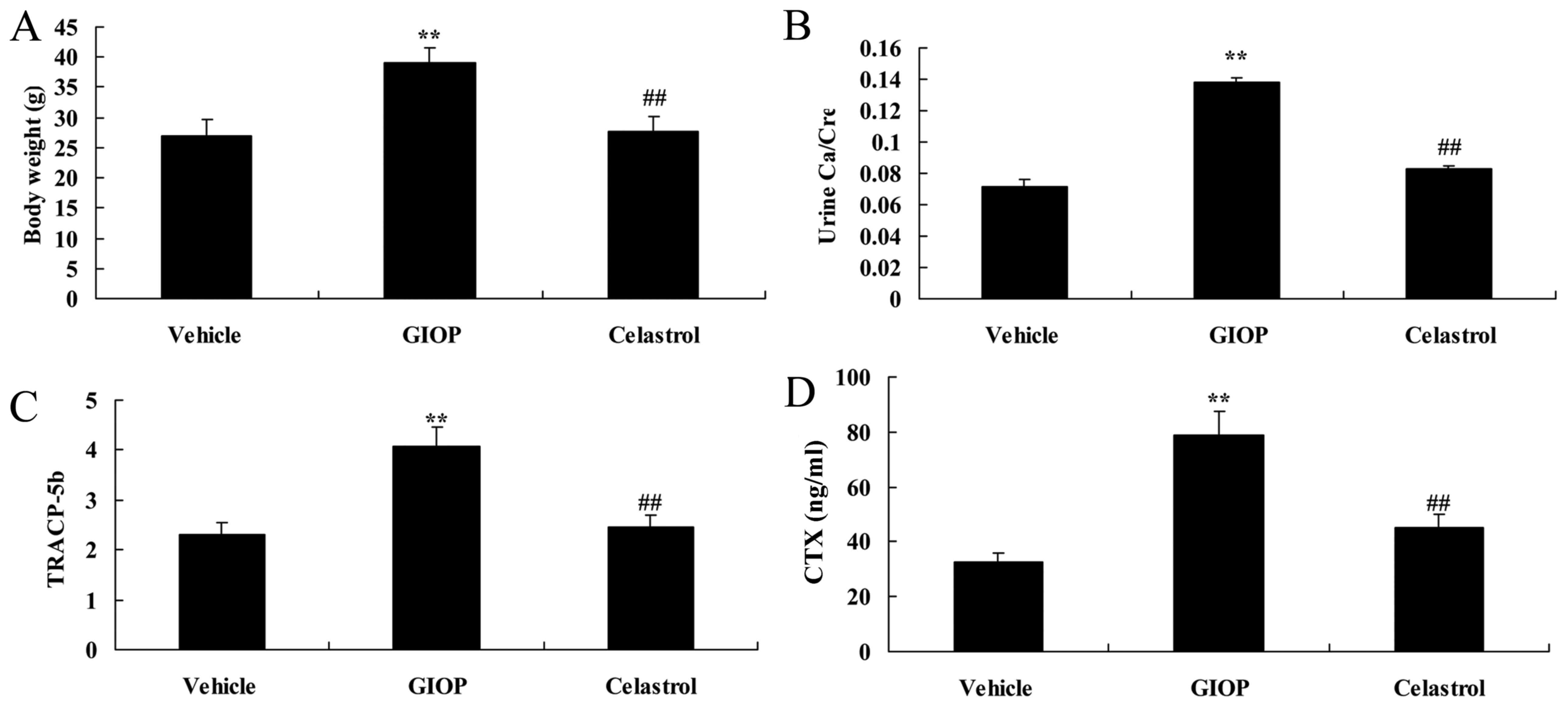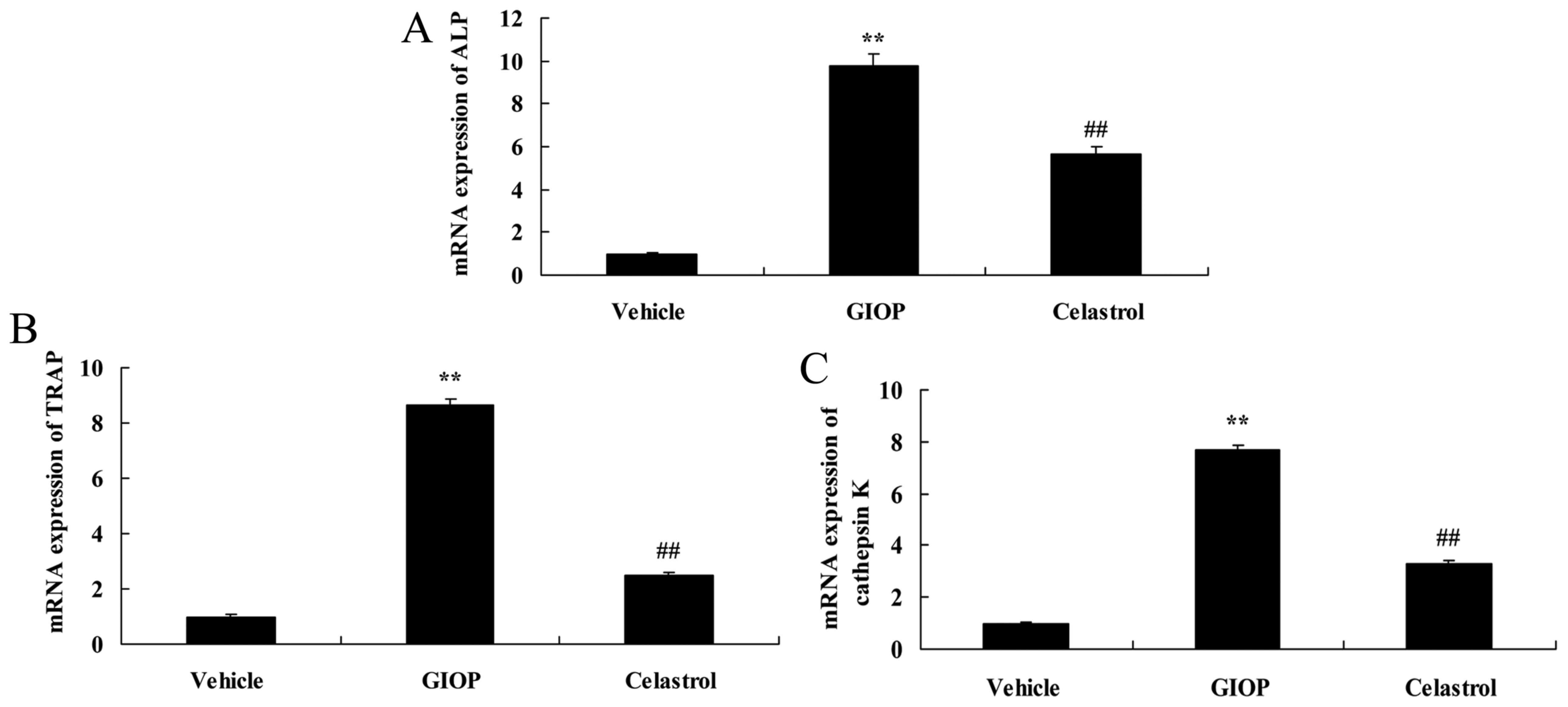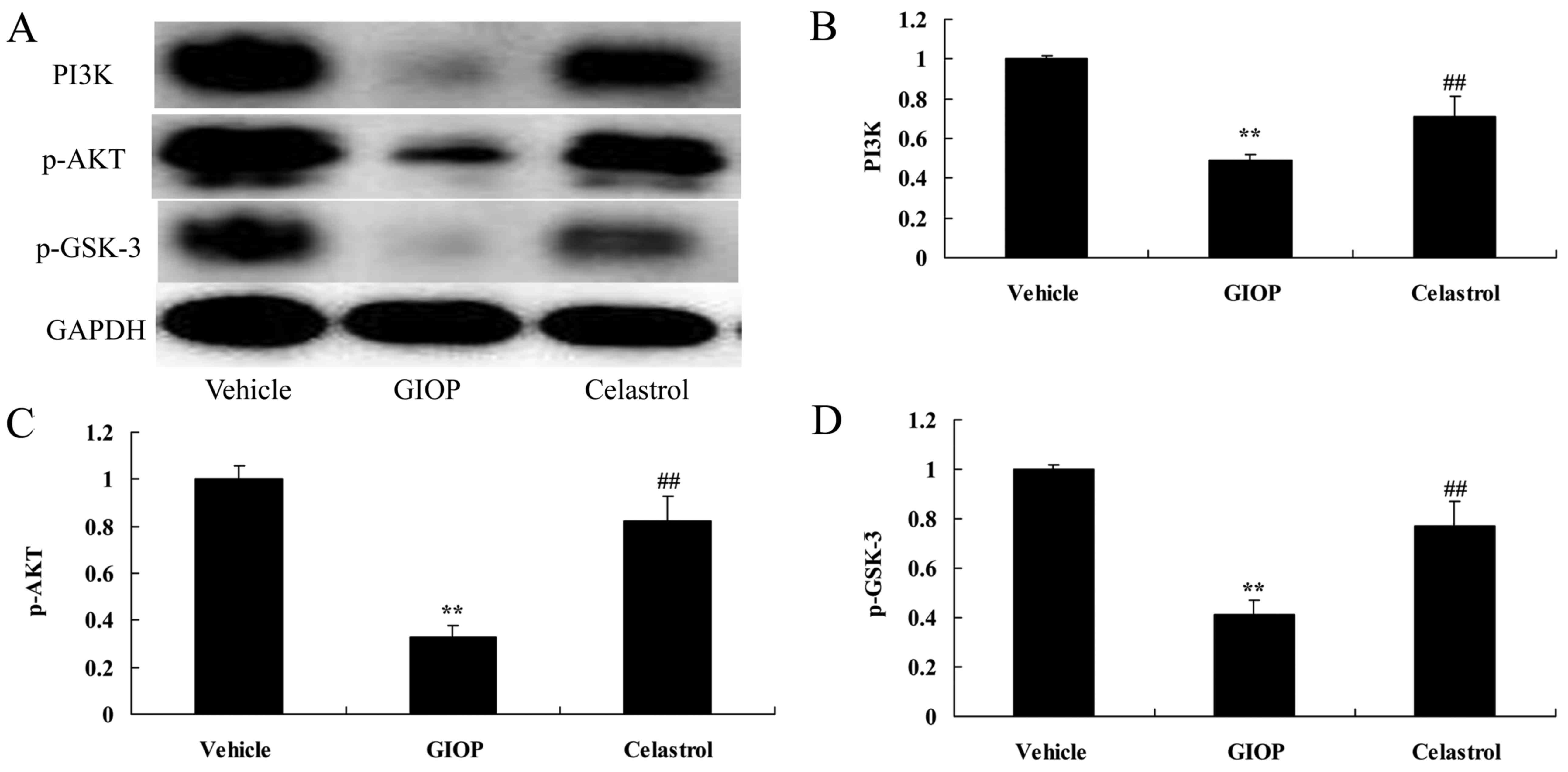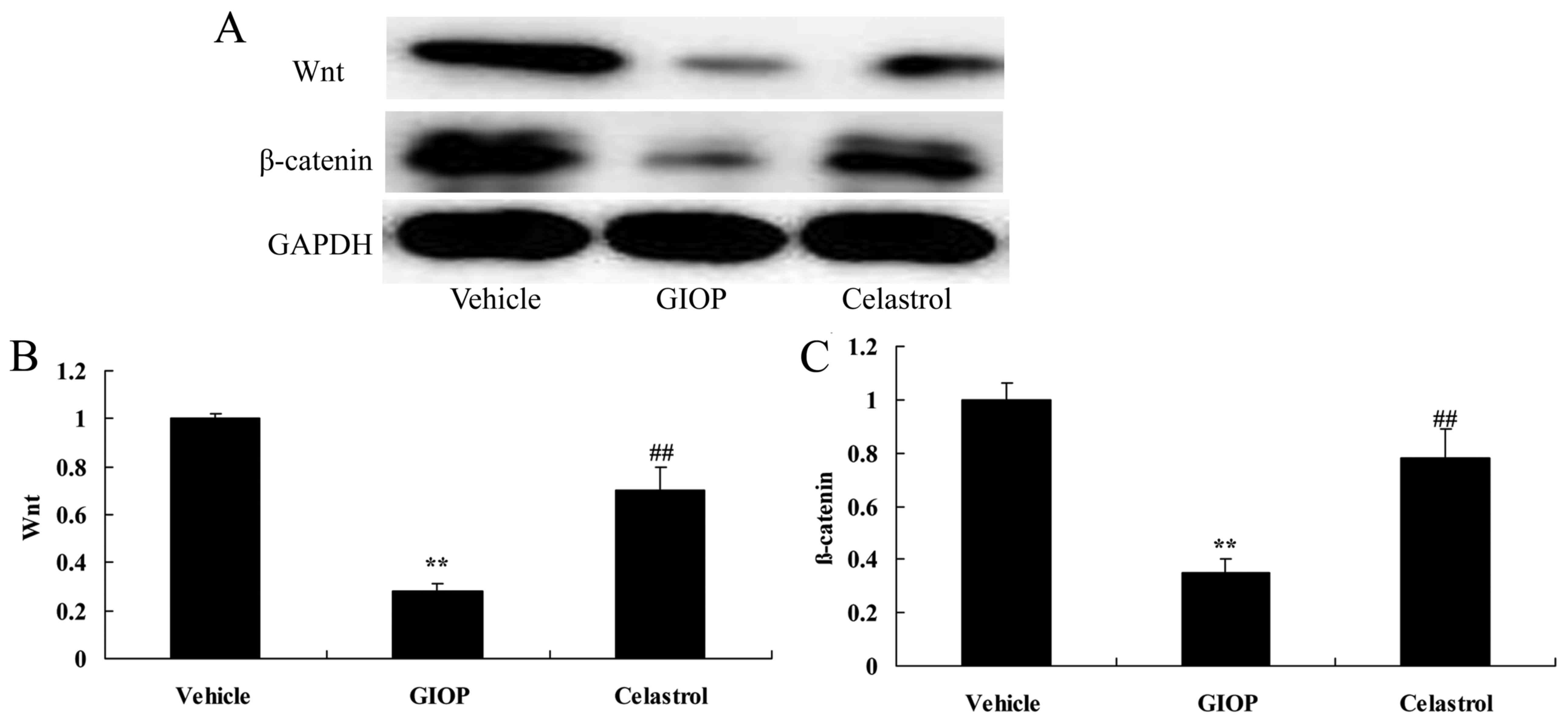Celastrol inhibits glucocorticoid‑induced osteoporosis in rat via the PI3K/AKT and Wnt signaling pathways
- Authors:
- Published online on: September 3, 2018 https://doi.org/10.3892/mmr.2018.9436
- Pages: 4753-4759
Abstract
Introduction
Osteoporosis is a systemic bone disease characterized by low bone mass, damaged bone microstructure, increased fragility and susceptibility to fractures (1). Osteoporosis may be divided into primary osteoporosis and secondary osteoporosis. The former is subdivided into postmenopausal, elderly and idiopathic osteoporosis, and the latter includes osteoporosis caused by any disease or drug that affects the physiological function of bones, such as long-term and high-dose intake of glucocorticoids (2). Generally speaking, postmenopausal osteoporosis occurs in women during menopause, elderly osteoporosis affects people aged >70, and idiopathic osteoporosis mainly occurs in teenagers, although its pathogenesis remains to be elucidated (3). It has been previously reported that there are tens of millions of female and male osteoporosis patients in the United States, and billions of Chinese people suffer from low bone mass (3). Minor trauma may lead to fractures, teratogenesis, disability or death and other serious adverse consequences in osteoporosis patients, and therefore, osteoporosis has become one of primary factors affecting the quality of life of the elderly (4).
Under the action of the Wnt signaling pathway, mesenchymal stem cells differentiate into osteoblasts (5). The classic Wnt/β-catenin signal pathway in osteoblasts also regulates the formation of osteoclasts (6). Osteoblasts promote the expression of two factors required in the formation of osteoclasts, macrophage colony-stimulating factor and receptor activator for nuclear factor-κB ligand (RANKL). Osteoblasts also secrete and express osteoprotegerin (OPG), which is the decoy receptor of RANKL, and binding to osteoprotegerin may inhibit the interaction of RANK/RANKL, to inhibit the formation of osteoclasts (7). In osteoclast progenitor cells, when RANKL activates its receptor, osteoclasts will be stimulated to produce reactive oxygen species (7,8). Therefore, RANKL and OGP are key molecules bridging bone formation and bone resorption in bone remodeling.
Phosphoinositol 3-kinase (PI3K)/protein kinase B (AKT) is one of the most important signaling pathways that regulate cell proliferation, differentiation, survival, migration and metabolism (9). A previous study demonstrated that many signaling molecules involved in ossification selectively activate genes associated with the PI3K/AKT signaling pathway, and disturb the dynamic balance between bone formation and bone resorption during bone remodeling via the regulation of osteoblast and osteoclasts; therefore, this signaling pathway has a very important role in the incidence and development of osteoporosis (10).
Celastrus orbiculatus Thunb. belongs to the Celastrus genus of the Celastraceae family, and its root, stem, fruit and leaves may be used as medicine. It has been demonstrated that Celastrol (Fig. 1) has anti-oxidative and anti-inflammatory properties, inhibits atherosclerosis by lipoprotein oxidative modification and prevents against inflammation (11). Previous studies have revealed that Celastrol has anti-inflammatory, anti-bacterial, anti-viral, anti-fertility and insect-resistance functions, and has been used for the treatment of rheumatism, rheumatoid arthritis, blood diseases, skin diseases and as an agricultural insecticide (11,12). In the present study, bioinformatics analysis was used to investigate the effects of Celastrol on glucocorticoid-induced osteoporosis (GIOP) and the potential underlying molecular mechanisms.
Materials and methods
Animal treatment
Male C57BL/6J mice (8-weeks old, 20–22 g, n=30) were purchased from Beijing Vital River Laboratory Animal Technology Co., Ltd (Beijing, China). All mice were provided with food and water ad libitum, and were housed at a temperature of 22–23°C, a humidity of 55–60% and a 12/12 h light/dark cycle. The mice were randomly divided into three groups: i) Vehicle group (n=10); ii) GIOP model group (n=10); and iii) Celastrol treatment group (n=10). Mice were injected intramuscularly with 5 mg/kg body weight dexamethasone three times a week for 12 weeks. Mice in the Celastrol treatment group were injected with a daily dose of 1 mg/kg Celastrol (Sigma-Aldrich; Merck KGaA, Darmstadt, Germany) for 12 weeks. The study was approved by the Ethics Committee of the Department of Minimally Invasive Spine Surgery, The 309th Hospital of the People's Liberation Army (Beijing, China). Following treatment with Celastrol, body weight was determined. Urine calcium (cat. no. C004-2), creatinine (cat. no. A032) and tartrate resistant acid phosphatase-5b (TRACP-5b; cat. no. A058) were quantified using ELISA kits (Nanjing Jiancheng Bioengineering Institute, Nanjing, China).
Reverse transcription-quantitative polymerase chain reaction (RT-qPCR)
Total RNA was extracted using TRIzol reagent (Qiagen, Inc., Valencia, CA, USA). cDNA was synthesized using a High-Capacity cDNA Reverse Transcription kit (cat. no. 4368813; Invitrogen; Thermo Fisher Scientific, Inc., Waltham, MA, USA). A RT-qPCR instrument (model ABI 7300) was used to analyze aleurain-like protease (ALP), triiodothyronine receptor auxiliary protein (TRAP), cathepsin K, osteocalcin, bone morphogenetic protein 2 (BMP-2), type I collagen, runt-related transcription factor 2 (Runx-2) mRNA expression levels using a SYBR Green-containing PCR kit (Shanghai GenePharma, Co., Ltd., Shanghai, China). The primer sequences used for qPCR were as follows: ALP forward, 5′-CCAGGGCGTACGGAGGCCATT-3′ and reverse, 5′-GACCAAATTACGGCGTAGCCTC-3′; TRAP forward, 5′-AGCATAAGGGTCCAAGTCCAA-3′ and reverse, 5′-TACCAAAAGCGGCGTAGTTA-3′; cathepsin K forward, 5′-AGGCGGAGGTCGATGCCCCG-3′ and reverse, 5′-CACGATGATGTCACCCTCGATGT-3′; osteocalcin forward, 5′-ATGAGAGCCCTCACACTCCT-3′ and reverse, 5′-CTTGGACACAAAGGCTGCAC-3′; BMP-2 forward, 5′-CAGCTTCCACCATGAAGAAT-3′, and reverse, 5′-CCAACCTGGTGTCCAAAAGT-3′; type I collagen forward, 5′-CCTGGATGCCATCAAAGTCT-3′, and reverse, 5′-ACTGCAACTGGAATCCATCG-3′; Runx-2 forward, 5′-CTCCCTGAACTCTGCACCAA-3′, and reverse, 5′-GTTCTGAAGCACCTGAAATGCG-3′; and GAPDH forward, 5′-ACAGGGGAGGTGATAGCATT-3′ and reverse, 5′-GACCAAAAGCCTTCATACATCTC-3′. The PCR conditions were as follows: Initial denaturation for 10 min at 95°C; followed by 40 cycles of denaturation for 30 sec at 95°C, annealing for 30 sec at 60°C and a final extension for 30 sec at 72°C. The method for quantification used was the 2−∆∆Cq method (13).
Western blot analysis
Total proteins were extracted from tissue samples using radioimmunoprecipitation assay (Thermo Fisher Scientific, Inc.) and the protein concentration was quantified in triplicate using the Pierce™ bicinchoninic acid protein assay kit (Thermo Fisher Scientific, Inc.). A total of 25 µg was subjected to 8–12% SDS-PAGE and directly transferred to nitrocellulose membranes (Sigma-Aldrich; Merck KGaA). Membranes were blocked with 5% non-fat milk in Tris-buffered saline containing 0.1% Tween 20 for 1 h at 37°C and then hybridized with the following primary antibodies: Anti-Wnt (cat. no. ab32249; 1:500; Abcam, Cambridge, UK), anti-β-catenin (cat. no. ab16051; 1:500; Abcam), PI3K (cat. no. sc-7174; 1:500; Santa Cruz Biotechnology, Inc., Dallas, TX, USA), phosphorylated (p)-AKT (cat. no. sc-7985-R; 1:500; Santa Cruz Biotechnology, Inc.), p-glycogen synthase kinase-3 (GSK-3; cat. no. sc-81497; 1:500; Santa Cruz Biotechnology, Inc.), prostaglandin E2 (PGE-2; cat. no. ab96189; 1:500; Abcam), caspase-3 (cat. no. sc-98785; 1:500; Santa Cruz Biotechnology, Inc.) and GAPDH (cat. no. sc-25778; 1:5,000; Santa Cruz Biotechnology, Inc.) at 4°C overnight. The membranes were incubated with anti-rabbit horseradish peroxidase-conjugated secondary antibodies (cat. no. 7074; 1:5,000; Cell Signaling Technology, Inc., Danvers, MA, USA) at the room temperature in the dark for 2 h. The blots were developed using enhanced chemiluminescence plus kits (GE Healthcare, Chicago, IL, USA), and densitometric analysis was performed using Image_Lab_3.0 software (Bio-Rad Laboratories, Inc., Hercules, CA, USA).
Statistical analysis
All experimental data are presented as the mean ± standard error of the mean. Comparison between groups was performed using a one-way analysis of variance followed by Tukey's Honest Significant Difference post-hoc test. P<0.05 was considered to indicate a statistically significant difference.
Results
Celastrol reduces body weight, urine Ca/Cre, TRACP-5b, C-terminal telopeptide of type I collagen (CTX)
Body weight, urine Ca/Cre, TRACP-5b and CTX were increased in GIOP mice when compared with the vehicle group (Fig. 2). Celastrol treatment inhibited these factors when compared with the GIOP group (Fig. 2).
Celastrol reduces ALP, TRAP and cathepsin K mRNA expression levels
The present study quantified ALP, TRAP and cathepsin K mRNA expression levels in GIOP mice following Celastrol treatment. Fig. 3 demonstrated that ALP, TRAP and cathepsin K mRNA expression levels in GIOP mice were higher compared with the vehicle group. Treatment with Celastrol significantly reduced ALP, TRAP and cathepsin K mRNA expression levels compared with the GIOP group (Fig. 3).
Celastrol inhibits osteocalcin, BMP-2, type I collagen, Runx-2 mRNA expression levels
Osteocalcin, BMP-2, type I collagen, Runx-2 mRNA expression levels were determined in GIOP mice after Celastrol treatment. There was significant inhibition of osteocalcin, BMP-2, type I collagen, runx-2 mRNA expression in GIOP mice, compared with the vehicle group, which was significantly reversed in the group which received Celastrol treatment compared with the GIOP group (Fig. 4).
Celastrol reduces PGE-2 and caspase-3 protein expression levels
The mechanism of Celastrol on PGE-2 and caspase-3 protein expression was investigated using western blot analysis. PGE-2 and caspase-3 protein expression levels in GIOP mice were higher compared with the vehicle group (Fig. 5). Treatment with Celastrol significantly reduced PGE-2 and caspase-3 protein expression levels when compared with the GIOP group (Fig. 5).
Celastrol increases PI3K, p-AKT and p-GSK-3 protein expression levels
To test the anti-apoptotic mechanism of Celastrol on osteoporosis, PI3K, p-AKT and p-GSK-3 protein expression levels were measured using western blot analysis. The results of western blot analysis showed that PI3K, p-AKT and p-GSK-3 protein expressions were significantly suppressed in GIOP mice compared with the vehicle group (Fig. 6). Celastrol treatment significantly increased PI3K, p-AKT and p-GSK-3 protein expression levels when compared with the GIOP group (Fig. 6).
Celastrol increases Wnt and β-catenin protein expression levels
The underlying molecular mechanism by which Celastrol regulates osteoporosis was subsequently investigated. It was determined that Wnt and β-catenin protein expression levels were significantly inhibited in GIOP mice compared with the vehicle group (Fig. 7). Treatment with Celastrol significantly increased Wnt and β-catenin protein expression levels in GIOP mice (Fig. 7).
Discussion
Osteoporosis is a systemic bone disease characterized by low bone mass, damaged bone microstructure, increased fragility and susceptibility to fracture (14). Minor trauma in osteoporosis patients may lead to development of fractures, disability or death; therefore, osteoporosis has become one of the primary factors affecting the quality of life of the elderly (15). Estrogen deficiency-induced bone loss is believed to be the primary cause of elderly osteoporosis (15). To the best of our knowledge the present study may provide the first evidence in examining whether Celastrol inhibits body weight, osteoporosis and PGE-2 and caspase-3 protein expression levels in GIOP mice.
Under normal circumstances, the PI3K/AKT signaling pathway selectively affects the physiological function of osteoblasts and osteoclasts and is activated by oxidative stress. The PI3K/AKT pathway acts on specific target genes, such as forkhead transcription factor (FOXO) and GSK-3β, to reduce the oxidative damage of osteoblasts and osteoclasts (10). Previous studies have revealed that insulin, insulin growth factor and other growth factors activate the PI3K/AKT signaling pathway, selectively regulating Wnt, FOXO, BMP and RANKL, and other signaling pathways, affecting the formation and differentiation of osteoblasts and osteoclasts and their functions, to regulate bone mass and bone strength (9,16). Therefore, as the center regulating the function of osteoblasts and osteoclasts, the PI3K/AKT signaling pathway has an important role in maintaining the dynamic equilibrium of bone tissues under normal physiological stimulation and pathological conditions and PI3K/AKT may be a target for the treatment of osteoporosis (16). Shrivastava et al (17) demonstrated that Celastrol induced apoptosis in breast cancer via the PI3K/AKT pathway. The present study revealed that Celastrol significantly induced PI3K, p-AKT and p-GSK-3 protein expression levels in GIOP mice. This data suggested that Celastrol may have a significant effect on the suppression of bone cell apoptosis in GIOP mice via the PI3K/AKT pathway.
The Wnt signaling pathway regulates the growth, development, illness, aging and mortality (18). In the Wnt signaling pathway, activation of Wnt leads to the phosphorylation of the signaling molecule β-catenin and its accumulation in the nucleus, which interacts with T cytokine/lymphoid enhancement factor to mediate Wnt-induced gene transcription, and guide the differentiation of bone marrow mesenchymal stem cells into osteoblasts (6,19). In bones, the Wnt/β-catenin pathway is vital for osteogenic differentiation and β-catenin may bind to nuclear transcription factors after entering the nucleus, to regulate a variety of proteins associated with osteogenic differentiation (5). BMP-2, a subtype of the transforming growth factor-β superfamily, has an important role in bone formation and bone metabolic balance in adults (20). C2C12 cells may differentiate from muscle cells into osteoblasts under the continuous stimulation of BMP-2 (21). A previous study has revealed that β-catenin is vital to osteogenic differentiation and is downstream of the Wnt/β-catenin pathway and regulates osteogenic differentiation via the Wnt autocrine loop (22). The present study demonstrated that treatment with Celastrol significantly promoted Wnt and β-catenin protein expression levels in GIOP mice. Lin et al (12) previously reported that Celastrol ameliorates ulcerative colitis-associated colorectal cancer through β-catenin expression. The findings of the present study are consistent with previous finding (12) regarding the role of Celastrol as an effective activator of the Wnt/β-catenin pathway in GIOP mice and has a protective effect.
In conclusion, Celastrol treatment reduced body weight, prevented osteoporosis and inhibited PGE-2 and caspase-3 protein expression levels in GIOP mice via the PI3K/AKT and Wnt signaling pathways. The present study in conjunction with previously published findings, suggested that Celastrol may be a potential therapeutic drug against osteoporosis in the clinic.
Acknowledgements
Not applicable.
Funding
No funding was received.
Availability of data and materials
The datasets used and/or analyzed during the current study are available from the corresponding author on reasonable request.
Authors' contributions
XL designed the study; JX, QL, YW, JL, LG and GW performed the experiments; JX and XL analyzed the data; XL wrote the manuscript.
Ethics approval and consent to participate
The study was approved by the Ethics Committee of the Department of Minimally Invasive Spine Surgery, The 309th Hospital of the People's Liberation Army (Beijing, China).
Consent for publication
Not applicable.
Competing interests
The authors declare that they have no competing interests.
References
|
Reginster JY, Kaufman JM, Goemaere S, Devogelaer JP, Benhamou CL, Felsenberg D, Diaz-Curiel M, Brandi ML, Badurski J, Wark J, et al: Maintenance of antifracture efficacy over 10 years with strontium ranelate in postmenopausal osteoporosis. Osteoporos Int. 23:1115–1122. 2012. View Article : Google Scholar : PubMed/NCBI | |
|
Chen GZ, Xu YX, Zhang JW, Liu SH and Guo ZY: Effect of acupoint catgut-embedding on the quality of life, reproductive endocrine and bone metabolism of postmenopausal women. Chin J Integr Med. 16:498–503. 2010. View Article : Google Scholar : PubMed/NCBI | |
|
McColm J, Hu L, Womack T, Tang CC and Chiang AY: Single- and multiple-dose randomized studies of blosozumab, a monoclonal antibody against sclerostin, in healthy postmenopausal women. J Bone Miner Res. 29:935–943. 2014. View Article : Google Scholar : PubMed/NCBI | |
|
Tee SI, Yosipovitch G, Chan YC, Chua SH, Koh ET, Chan YH, Tan SS, Tsou IY and Tan SH: Prevention of glucocorticoid-induced osteoporosis in immunobullous diseases with alendronate: A randomized, double-blind, placebo-controlled study. Arch Dermatol. 148:307–314. 2012. View Article : Google Scholar : PubMed/NCBI | |
|
Wang F, Wang Y, Zhao Y, Zhan Q, Yu P, Wang J and Xue C: Sialoglycoprotein isolated from eggs of carassius auratus ameliorates osteoporosis: An effect associated with regulation of the Wnt/β-catenin pathway in rodents. J Agric Food Chem. 64:2875–2882. 2016. View Article : Google Scholar : PubMed/NCBI | |
|
Karner CM and Long F: Wnt signaling and cellular metabolism in osteoblasts. Cell Mol Life Sci. 74:1649–1657. 2017. View Article : Google Scholar : PubMed/NCBI | |
|
Kanzaki H, Shinohara F, Itohiya K, Yamaguchi Y, Katsumata Y, Matsuzawa M, Fukaya S, Miyamoto Y, Wada S and Nakamura Y: RANKL induces Bach1 nuclear import and attenuates Nrf2-mediated antioxidant enzymes, thereby augmenting intracellular reactive oxygen species signaling and osteoclastogenesis in mice. FASEB J. 31:781–792. 2017. View Article : Google Scholar : PubMed/NCBI | |
|
Gu DR, Lee JN, Oh GS, Kim HJ, Kim MS and Lee SH: The inhibitory effect of beta-lapachone on RANKL-induced osteoclastogenesis. Biochem Biophys Res Commun. 482:1073–1079. 2017. View Article : Google Scholar : PubMed/NCBI | |
|
Xi JC, Zang HY, Guo LX, Xue HB, Liu XD, Bai YB and Ma YZ: The PI3K/AKT cell signaling pathway is involved in regulation of osteoporosis. J Recept Signal Transduct Res. 35:640–645. 2015. View Article : Google Scholar : PubMed/NCBI | |
|
Li XJ, Zhu Z, Han SL and Zhang ZL: Bergapten exerts inhibitory effects on diabetes-related osteoporosis via the regulation of the PI3K/AKT, JNK/MAPK and NF-κB signaling pathways in osteoprotegerin knockout mice. Int J Mol Med. 38:1661–1672. 2016. View Article : Google Scholar : PubMed/NCBI | |
|
Guan Y, Cui ZJ, Sun B, Han LP, Li CJ and Chen LM: Celastrol attenuates oxidative stress in the skeletal muscle of diabetic rats by regulating the AMPK-PGC1alpha-SIRT3 signaling pathway. Int J Mol Med. 37:1229–1238. 2016. View Article : Google Scholar : PubMed/NCBI | |
|
Lin L, Sun Y, Wang D, Zheng S, Zhang J and Zheng C: Celastrol ameliorates ulcerative colitis-related colorectal cancer in mice via suppressing inflammatory responses and epithelial-mesenchymal transition. Front Pharmacol. 6:3202016. View Article : Google Scholar : PubMed/NCBI | |
|
Livak KJ and Schmittgen TD: Analysis of relative gene expression data using real-time quantitative PCR and the 2(-Delta Delta C(T)) method. Methods. 25:402–408. 2001. View Article : Google Scholar : PubMed/NCBI | |
|
Koh JM, Chung DJ, Chung YS, Kang MI, Kim IJ, Min YK, Oh HJ, Park IH, Lee YS, Kravitz B, et al: Assessment of Denosumab in Korean postmenopausal women with osteoporosis: Randomized, double-blind, placebo-controlled trial with open-label extension. Yonsei Med J. 57:905–914. 2016. View Article : Google Scholar : PubMed/NCBI | |
|
Tüzün Ş, Akyüz G, Eskiyurt N, Memiş A, Kuran B, İçağasıoğlu A, Sarpel T, Özdemir F, Özgirgin N, Günaydın R, et al: Impact of the training on the compliance and persistence of weekly bisphosphonate treatment in postmenopausal osteoporosis: A randomized controlled study. Int J Med Sci. 10:1880–1887. 2013. View Article : Google Scholar : PubMed/NCBI | |
|
You L, Gu W, Chen L, Pan L, Chen J and Peng Y: MiR-378 overexpression attenuates high glucose-suppressed osteogenic differentiation through targeting CASP3 and activating PI3K/Akt signaling pathway. Int J Clin Exp Pathol. 7:7249–7261. 2014.PubMed/NCBI | |
|
Shrivastava S, Jeengar MK, Reddy VS, Reddy GB and Naidu VG: Anticancer effect of celastrol on human triple negative breast cancer: Possible involvement of oxidative stress, mitochondrial dysfunction, apoptosis and PI3K/Akt pathways. Exp Mol Pathol. 98:313–327. 2015. View Article : Google Scholar : PubMed/NCBI | |
|
Wang Y, Li YP, Paulson C, Shao JZ, Zhang X, Wu M and Chen W: Wnt and the Wnt signaling pathway in bone development and disease. Front Biosci (Landmark Ed). 19:379–407. 2014. View Article : Google Scholar : PubMed/NCBI | |
|
Adami G, Orsolini G, Adami S, Viapiana O, Idolazzi L, Gatti D and Rossini M: Effects of TNF inhibitors on parathyroid hormone and Wnt signaling antagonists in rheumatoid arthritis. Calcif Tissue Int. 99:360–364. 2016. View Article : Google Scholar : PubMed/NCBI | |
|
Liou SF, Hsu JH, Chu HC, Lin HH, Chen IJ and Yeh JL: KMUP-1 Promotes osteoblast differentiation through cAMP and cGMP pathways and signaling of BMP-2/Smad1/5/8 and Wnt/β-catenin. J Cell Physiol. 230:2038–2048. 2015. View Article : Google Scholar : PubMed/NCBI | |
|
Shen J, James AW, Zhang X, Pang S, Zara JN, Asatrian G, Chiang M, Lee M, Khadarian K, Nguyen A, et al: Novel Wnt regulator NEL-like molecule-1 antagonizes adipogenesis and augments osteogenesis induced by bone morphogenetic protein 2. Am J Pathol. 186:419–434. 2016. View Article : Google Scholar : PubMed/NCBI | |
|
Rawadi G, Vayssiere B, Dunn F, Baron R and Roman-Roman S: BMP-2 controls alkaline phosphatase expression and osteoblast mineralization by a Wnt autocrine loop. J Bone Miner Res. 18:1842–1853. 2003. View Article : Google Scholar : PubMed/NCBI |

















